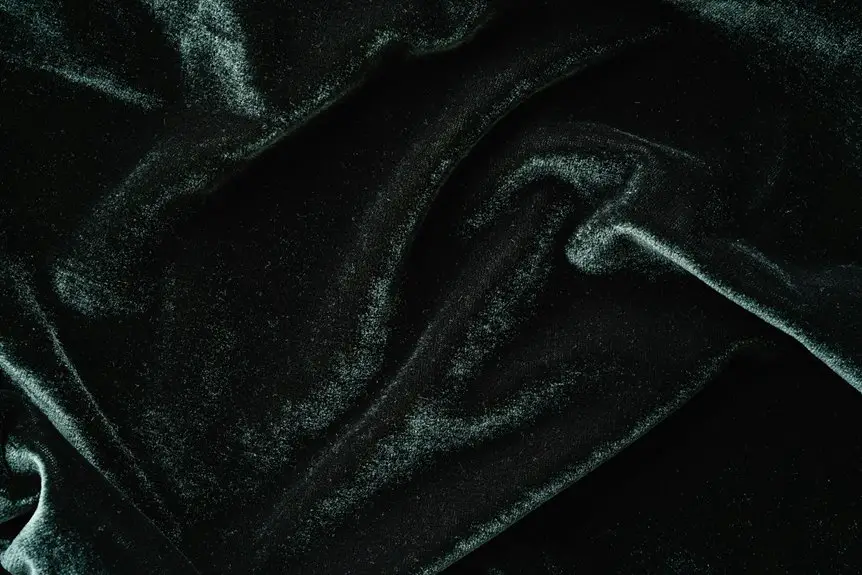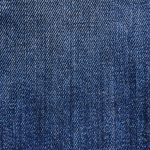You’ll find cotton sateen fabric shiny because its special weave floats more threads on the surface, creating a smoother, silkier finish that reflects light better than plain cotton. The use of long, fine cotton yarns and a tighter thread count further enhances this sheen by minimizing surface irregularities. Plus, finishing treatments boost fiber strength and gloss, making the fabric both durable and soft. If you want to understand how each factor contributes to that luxurious luster, keep exploring.
Table of Contents
Key Takeaways
- Cotton sateen’s shiny appearance comes from the satin weave, which floats threads over multiple yarns to create a smooth, reflective surface.
- Using long-staple, combed cotton fibers produces finer, smoother yarns that enhance the fabric’s natural luster and softness.
- Low-twist yarns align closely during weaving, minimizing surface irregularities and increasing light reflection for a glossy finish.
- High thread count in cotton sateen tightens the weave, reducing roughness and amplifying the fabric’s sheen and durability.
- Finishing treatments like mercerization and calendering strengthen fibers and polish the surface, boosting the fabric’s shine and longevity.
Understanding Cotton Fibers and Their Natural Properties
Although you might think cotton is just a simple fabric, its fibers have unique natural properties that affect the look and feel of cotton sateen.
You’ll find cotton fibers are naturally twisted and have a smooth surface that reflects light differently depending on how they’re treated. When you touch cotton, its softness comes from the fiber’s structure, which also influences breathability and moisture absorption.
Because cotton fibers are hollow, they trap air, making the fabric comfortable against your skin. The length and fineness of the cotton fibers also play a role; longer fibers create a smoother, more lustrous surface.
What Makes Sateen Weave Different From Plain Weave
You’ll notice that sateen weave differs from plain weave in its thread pattern, where more threads float over others, creating a smoother surface.
This change in structure gives sateen its characteristic soft texture and subtle sheen.
Understanding this contrast helps you appreciate why sateen feels silkier than plain woven cotton.
Weave Structure Comparison
When you compare sateen weave to plain weave, you’ll notice that sateen uses more floating yarns on the fabric’s surface, which gives it a smoother, shinier appearance. This structural difference is key to understanding their unique looks.
1. Yarn Interlacing: Plain weave alternates each yarn over and under one another, creating a tight, matte surface.
Sateen weave floats yarns over multiple threads before interlacing, allowing light to reflect more.
2. Float Length: Sateen’s longer floats reduce yarn intersections on the surface, increasing smoothness and sheen, unlike the short floats in plain weave.
3. Yarn Orientation: In sateen, the surface mainly shows the filling yarns, which are often finer and smoother, enhancing the lustrous effect compared to the balanced yarn exposure in plain weave.
Impact on Fabric Texture
The texture of sateen fabric feels noticeably smoother and more luxurious compared to plain weave, thanks to its unique construction. Unlike the simple over-under pattern of plain weave, sateen uses a satin weave where multiple weft threads pass over a single warp thread. This technique exposes more yarn surface, giving you that silky feel and subtle sheen. You’ll also notice sateen’s drape is softer, making it ideal for bedding and apparel.
| Feature | Sateen Weave | Plain Weave |
|---|---|---|
| Yarn Exposure | More surface yarns exposed | Alternating yarns exposed |
| Texture | Smooth and lustrous | Crisp and matte |
| Durability | Slightly less durable | More durable |
| Drape | Soft and fluid | Stiff and structured |
| Sheen | Noticeable shine | Minimal shine |
The Role of Weaving Techniques in Fabric Appearance
You’ll notice that the satin weave structure plays a big role in how cotton sateen looks.
The way threads float over each other creates that smooth, glossy surface you see.
Understanding these thread float effects helps you appreciate the fabric’s unique sheen.
Satin Weave Structure
Explore how satin weave structures transform fabric surfaces by creating a smooth, lustrous finish.
When you look closely at cotton sateen, the satin weave plays a key role in its shiny appeal. This technique arranges the threads to minimize visible intersections, making the surface reflect light brilliantly.
Here’s how it works:
- Satin weave floats the warp yarns over multiple weft yarns, reducing the number of interlacings.
- This floating pattern produces a smoother surface that light can bounce off more evenly.
- The weave’s unique structure allows the fabric to drape gracefully, enhancing its sheen and softness.
Thread Float Effects
Although weaving techniques may seem technical, they directly influence how a fabric looks and feels.
In cotton sateen, thread floats play an essential role in creating that signature sheen. When threads “float” over several others instead of interlacing at every point, they produce a smoother surface. This smoothness reflects light more uniformly, giving the fabric its shiny appearance.
You can think of thread floats as tiny bridges of yarn that reduce interruptions on the surface, enhancing luster. The longer the floats, the more light bounces off, intensifying the shine. However, too long floats can weaken the fabric, so manufacturers balance durability with appearance.
Understanding thread float effects helps you appreciate why cotton sateen feels luxuriously smooth and gleams softly under light.
How Thread Count Influences Shine and Smoothness
Several factors affect the sheen and smoothness of cotton sateen, but thread count plays a crucial role. When you choose a higher thread count, you’re fundamentally opting for a denser weave, which impacts the fabric’s appearance and feel.
Here’s how thread count influences shine and smoothness:
- Surface Texture: Higher thread counts create a tighter weave, producing a smoother surface that reflects light evenly, enhancing the fabric’s shine.
- Durability: More threads per square inch mean the fabric resists wear better, maintaining its sheen longer.
- Softness: Dense thread arrangements reduce roughness, making the fabric feel softer and more luxurious against your skin.
The Impact of Yarn Type on Cotton Sateen Luster
Because the type of yarn used directly affects how cotton sateen reflects light, understanding its impact is key to appreciating the fabric’s luster.
When you choose combed or long-staple cotton yarns, you get smoother, stronger fibers that align better during weaving. This alignment enhances the fabric’s sheen by minimizing irregularities.
On the other hand, shorter staple yarns tend to create a rougher surface, dulling the shine. The yarn’s twist also matters: low-twist yarns produce a softer, more reflective surface, while high-twist yarns add texture but reduce luster.
Light Reflection and Surface Smoothness in Sateen
When light hits the smooth surface of cotton sateen, it reflects in a way that gives the fabric its characteristic sheen. This shine results from how the fabric’s surface interacts with light.
You’ll notice that the smoothness allows light to bounce off uniformly rather than scattering. Here’s why that matters:
- Surface Smoothness: The tightly woven yarns create a flat, even surface that acts like a mirror, reflecting more light directly to your eyes.
- Light Reflection: The angle and quality of reflection enhance the fabric’s brightness, making it appear lustrous and vibrant.
- Reduced Diffusion: Unlike rougher fabrics, sateen minimizes light diffusion, preserving a sharp and glossy look.
Comparing Cotton Sateen to Other Types of Cotton Fabric
Although cotton sateen shares the same base fiber as other cotton fabrics, you’ll notice it stands out due to its unique weave and finish.
Unlike plain weave cottons, which have a crisscross pattern, sateen uses a satin weave that places more threads on the surface. This design creates a smoother, denser fabric that reflects light differently, giving it that distinctive sheen.
When you compare cotton sateen to cotton twill or voile, the sateen’s surface feels silkier and looks glossier. Twill has a diagonal ribbed texture, and voile is lightweight and sheer, both lacking sateen’s smoothness and luster.
Finishing Processes That Enhance Cotton Sateen Shine
To bring out the signature sheen of cotton sateen, manufacturers apply specific finishing techniques that enhance its smooth surface and light-reflecting qualities.
These processes refine the fabric’s texture and amplify its natural luster, making it stand apart from other cotton textiles. When you examine cotton sateen closely, you’ll notice the result of these careful treatments:
- Calendering – Passing the fabric through heated rollers compresses the fibers, creating a glossy, polished finish.
- Mercerization – Treating cotton with a caustic soda solution increases fiber strength and imparts a silk-like shine.
- Resin Finishing – Applying resin coatings smooths the fabric and boosts its sheen while enhancing durability.
Each step contributes to the silky, reflective quality that defines cotton sateen’s elegant appearance.
Practical Benefits of Cotton Sateen’s Glossy Finish
Because cotton sateen’s glossy finish reflects light so beautifully, it offers more than just an attractive look—you’ll find it adds real value in everyday use.
That smooth sheen makes stains and wrinkles less noticeable, so your clothes and linens stay looking fresh longer between washes. When you wear cotton sateen, the subtle shine elevates your outfit, giving you a polished appearance without extra effort.
Plus, the finish helps the fabric feel softer against your skin, enhancing comfort throughout the day. If you use cotton sateen for bedding or drapes, the lustrous surface adds a touch of luxury to your space, making it feel inviting and elegant.
In short, the glossy finish combines style and practicality in one versatile fabric.
Frequently Asked Questions
How Do Washing and Drying Affect Cotton Sateen’S Shine?
You’ll think washing cotton sateen dulls its shine forever! But if you use gentle cycles and avoid harsh detergents, you’ll keep that glossy look. Drying on low heat or air-drying helps preserve its smooth, lustrous finish.
Can Cotton Sateen Fabric Be Dyed Easily?
You can dye cotton sateen easily because it’s made from natural cotton fibers that absorb dye well. Just make sure to use the right dye and follow instructions for even, vibrant color results on the fabric.
Is Cotton Sateen Fabric Hypoallergenic?
You won’t turn into a sneezing monster wearing cotton sateen! It’s naturally hypoallergenic, so it resists dust and irritants, keeping your skin calm and comfy. Perfect if you want softness without the sniffles or itchiness.
What Is the Best Way to Store Cotton Sateen Clothing?
You should store cotton sateen clothing in a cool, dry place away from direct sunlight. Hang items on padded hangers or fold them neatly to prevent wrinkles and maintain their smooth, lustrous finish over time.
Does Cotton Sateen Shrink After the First Wash?
Yes, cotton sateen can shrink after the first wash, especially if washed in hot water or dried on high heat. You should wash it in cold water and air dry or use low heat to minimize shrinkage.







